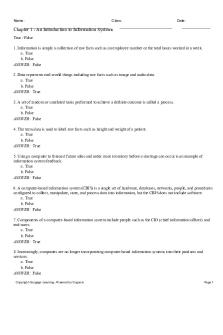BFOR 100 lecture 1 - professor prinkle sharma bfor 100 intro to information systems PDF

| Title | BFOR 100 lecture 1 - professor prinkle sharma bfor 100 intro to information systems |
|---|---|
| Course | Introduction to Information Systems |
| Institution | University at Albany |
| Pages | 2 |
| File Size | 80.4 KB |
| File Type | |
| Total Downloads | 48 |
| Total Views | 151 |
Summary
professor prinkle sharma bfor 100 intro to information systems...
Description
BFOR 100 – INTRODUCTION TO INFORMATION SYSTEMS LECTURE 1 Data: raw facts & figures that relay something but not in an organized way Information: collection of data organized, contextualized, categorized, calculated, & processed that adds value beyond the data Knowledge: awareness & understanding of the information to make a decision
Overview of information system
Kno wle Infor dge mat on Dat a
Information technology: any computer-based tool that people use to work with information & to support an organization’s information & information processing needs Information system: a set of interrelated components that collects, processes, stores, analyzes, & disseminates information to meet a specific goal Components of information system Purpose of each component Hardware: device like the monitor, processor, printer, & keyboard, all of which work together to accept, process, show date, & information Software: programs that allow the hardware to process the data Databases: gathering of associated files/tables containing related data Networks: connecting systems that allow diverse computers to distribute resources Procedures: commands for combining the components above to process information & produce the preferred output People: run the system & procedures they follow so that the data knowledge can be turned into learning
Types of information system - Executive information system - Decision support system - Management information system - Transaction processing system Transacton processing systems consist of computer hardware and software hosting a transacton-oriented application that performs the routine transactons necessary to conduct business. Examples include systems that manage sales order entry, airline reservations, payroll, employee records, manufacturing, and shipping. Management covers the planning, control, and administraton of the operations of a concern. It helps the management in planning, controlling and operations. The central objective of MIS is to provide information to every resource of a company so that they can take an instant decision without any delay. is a computer system consisting of hardware and software that serves as the backbone of an organization's operations. DSS is a computerized-based information system that organizes, collects, and analyzes business data that can be used in decision-making activities for the management, operations, and planning in an organization or business. An Executve Informaton System (EIS) is a kind of decision support system (DSS) used in organizations to help executives in decision making. It does so by providing easy access to important data needed in an organization to achieve strategic goals. An EIS usually has graphical displays on a user-friendly interface.
Challenges of information system - Cloud computing - Cybersecurity - Data security - Open source software - Mobile payments - Internet of things - Remote access...
Similar Free PDFs

BFOR 201 Lecture Notes 6
- 8 Pages

IDS 100 Syllabus ~ Information
- 6 Pages

ABS 100 note - Professor Maufin
- 21 Pages

SOC-100 - 100%
- 5 Pages

Psychology 100 Lecture 4
- 3 Pages

CSA 100 - CSA 100
- 30 Pages

Anth 100 - Lecture notes
- 24 Pages

Psych 100 - lecture notes
- 20 Pages

Lecture 1 - Intro to Biomaterials
- 11 Pages

ELEC4612- Intro to power systems
- 7 Pages

ACT 4 HV - 100/100
- 2 Pages
Popular Institutions
- Tinajero National High School - Annex
- Politeknik Caltex Riau
- Yokohama City University
- SGT University
- University of Al-Qadisiyah
- Divine Word College of Vigan
- Techniek College Rotterdam
- Universidade de Santiago
- Universiti Teknologi MARA Cawangan Johor Kampus Pasir Gudang
- Poltekkes Kemenkes Yogyakarta
- Baguio City National High School
- Colegio san marcos
- preparatoria uno
- Centro de Bachillerato Tecnológico Industrial y de Servicios No. 107
- Dalian Maritime University
- Quang Trung Secondary School
- Colegio Tecnológico en Informática
- Corporación Regional de Educación Superior
- Grupo CEDVA
- Dar Al Uloom University
- Centro de Estudios Preuniversitarios de la Universidad Nacional de Ingeniería
- 上智大学
- Aakash International School, Nuna Majara
- San Felipe Neri Catholic School
- Kang Chiao International School - New Taipei City
- Misamis Occidental National High School
- Institución Educativa Escuela Normal Juan Ladrilleros
- Kolehiyo ng Pantukan
- Batanes State College
- Instituto Continental
- Sekolah Menengah Kejuruan Kesehatan Kaltara (Tarakan)
- Colegio de La Inmaculada Concepcion - Cebu




